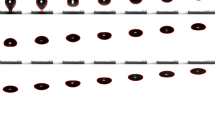Abstract
The bubble motion in a compressible liquid under a pressure pulsing condition was studied numerically by solving the conservation equations of mass and momentum. The bubble deformation was computed by a level-set method, which was modified to include the compressibility effects of bubble and liquid. The numerical results demonstrate that the presence of a bubble can significantly amplify the wall pressure near the bubble, and the wall also considerably increases the bubble pressure. The effects of surface tension, viscosity and the magnitude of pressure pulse on the bubble motion were quantified.
Similar content being viewed by others
References
J. I. Iloreta, N. M. Fung and A. J. Szeri, Dynamics of bubbles near a rigid surface subjected to a lithotripter shock wave: Part 1. Consequences of interference between incident and reflected waves, J. of Fluid Mechanics, 616 (2008) 43–61.
M. L. Calvisi, J. I. Iloreta and A. J. Szeri, Dynamics of bubbles near a rigid surface subjected to a lithotripter shock wave: Part 2. Reflected shock intensifies non-spherical cavitation collapse, J. of Fluid Mechanics, 616 (2008) 63–97.
E. Johnsen and T. Colonius, Shock-induced collapse of a gas bubble in shockwave lithotripsy, J. of the Acoustical Society of America, 124 (2008) 2011–2020.
E. Johnsen and T. Colonius, Numerical simulation of nonspherical bubble collapse, J. of Fluid Mechanics, 629 (2009) 231–262.
J. B. Freund, R. K. Shukla and A. P. Evan, Shock-induced bubble jetting into a viscous fluid with application to tissue injury in shock-wave lithotripsy, J. of Acoustical Society of America, 126 (2009) 2746–2756.
H. Terashima and G. Tryggvason, A front-tracking/ghost-fluid method for fluid interfaces in compressible flows, J. of Computational Physics, 228 (2009) 4012–4037.
K. Kobayashi, T. Kodama and H. Takahira, Shock wavebubble interaction near soft and rigid boundaries during lithotripsy: Numerical analysis by the improved ghost fluid method, Physics in Medicine & Biology, 56 (2011) 6421–6440.
S. Majidi and A. Afshari, A ghost fluid method for sharp interface simulations of compressible multiphase flows, J. of Mechanical Science and Technology, 30 (2016) 1581–1593.
R. P. Fedkiw, T. Aslam, B. Merrima and S. Osher, A nonoscillatory eulerian approach to interfaces in multimaterial flows (the Ghost fluid method), J. of Computational Physics, 152 (1999) 457–492.
N. Kwatra, J. Su, J. T. Gretarsson and R. Fedkiw, A method for avoiding the acoustic time step restriction in compressible flow, J. of Computational Physics, 228 (2009) 477–503.
J. T. Gretarsson and R. Fedkiw, Fully conservative leak-proof treatment of thin solid structures immersed in compressible fluids, J. of Computational Physics, 245 (2013) 160–204.
M. Jemisona, M. Sussman and M. Arienti, Compressible, multiphase semi-implicit method with moment of fluid interface representation, J. of Computational Physics, 279 (2014) 182–217.
G. Huber, S. Tanguy, J.-C. Bera and B. Gilles, A time splitting projection scheme for compressible two-phase flows. Application to the interaction of bubbles with ultrasound waves, J. of Computational Physics, 302 (2015) 439–468.
J. Lee and G. Son, A level-set method for ultrasound-driven bubble motion with a phase change, Numerical Heat Transfer, Part A, 71 (2017) 928–943.
H. Hwang and G. Son, Direct numerical simulation of 3D particle motion in an evaporating liquid film, J. of Mechanical Science and Technology, 30 (2016) 3929–3934.
D. Q. Nguyen, R. P. Fedkiw and M. Kang, A boundary condition capturing method for incompressible flame discontinuities, J. of Computational Physics, 172 (2001) 71–98.
R. Caiden, R. P. Fedkiw and C. Anderson, A numerical method for two-phase flow consisting of separate compressible and incompressible regions, J. of Computational Physics, 166 (2001) 1–27.
F. Gibou, R. P. Fedkiw, L.-T. Cheng and M. Kang, A second-order-accurate symmetric discretization of the poisson equation on irregular domains, J. of Computational Physics, 176 (2002) 205–227.
M. Sussman, K. M. Smith, M. Y. Hussaini, M. Ohta and R. Zhi-Wei, A sharp interface method for incompressible twophase flows, J. of Computational Physics, 221 (2007) 469–505.
R. P. Fedkiw, Coupling an Eulerian fluid calculation to a Lagrangian solid calculation with the ghost fluid method, J. of Computational Physics, 175 (2002) 200–224.
Author information
Authors and Affiliations
Corresponding author
Additional information
Recommended by Associate Editor Hyoung-gwon Choi
Sungwook Cho received his B.S. in Mechanical Engineering from Sogang University in 2017. He is currently a graduate student of Mechanical Engineering at Sogang University, Korea. Mr. Cho’s research interests are in the area of multiphase flow and heat transfer.
Gihun Son received his B.S. and M.S. in Mechanical Engineering from Seoul National University in 1986 and 1988, respectively, and his Ph.D. in Mechanical Engineering from UCLA in 1996. Dr. Son is currently a Professor of Mechanical Engineering at Sogang University, Korea. His research interests are in the areas of multiphase flow, heat transfer, and power plant simulation.
Rights and permissions
About this article
Cite this article
Cho, S., Son, G. & Kim, S. Numerical analysis of bubble motion under a pressure pulsing condition. J Mech Sci Technol 31, 5897–5904 (2017). https://doi.org/10.1007/s12206-017-1133-x
Received:
Revised:
Accepted:
Published:
Issue Date:
DOI: https://doi.org/10.1007/s12206-017-1133-x




